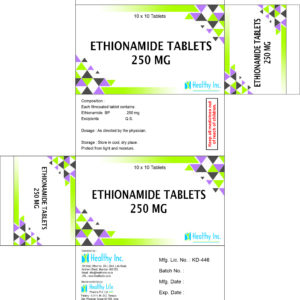Description
Pyrazinamide Tablets (400 mg/500mg / 750mg)
Manufactured by Healthy Life Pharma Pvt. Ltd. | Exported by Healthy Inc
1. Product Introduction Healthy Life Pharma Pvt. Ltd. is a premier manufacturer of Pyrazinamide Tablets in India. This medication is a first-line treatment for Tuberculosis (TB). We produce high-quality tablets for global health programs. Our facility adheres to strict WHO-GMP standards. Therefore, we guarantee safety and efficacy. Healthy Inc manages our global exports and government tenders.
2. Product Specifications | Parameter | Specification | | :— | :— | | Product Name | Pyrazinamide Tablets | | Generic Name | Pyrazinamide IP / BP / USP | | Strength |400 mg/ 500mg / 750mg | | Dosage Form | Uncoated / Film Coated Tablet | | Standard | USP / BP / IP Compliant | | Therapeutic Class | Anti-Tubercular Agent | | Shelf Life | 36 Months | | Packaging | 10×10 Blister / 28 Tabs Strip / Bulk Jar (1000s) |
3. Manufacturing Pyrazinamide Tablets We divide our operations to ensure specialized focus.
The Manufacturer: Healthy Life Pharma Pvt. Ltd. First, Healthy Life Pharma handles manufacturing. We operate a WHO-GMP certified plant in Mumbai. We use advanced compression technology. This ensures the tablets are hard enough to survive shipping but dissolve quickly in the stomach. We also control humidity strictly. This protects the chemical stability of Pyrazinamide Tablets.
The Exporter: Healthy Inc Second, Healthy Inc manages international trade. This division handles logistics for Pyrazinamide Tablets. We specialize in Anti-TB tenders for NGOs and Ministries of Health. Thus, we have high production capacity. We ensure timely shipment for mass treatment campaigns.
4. Quality Assurance We test every batch rigorously.
Assay Verification: We use HPLC testing. This confirms the drug content is accurate.
Dissolution: We test how the tablet releases the drug. Therefore, it fights the bacteria effectively.
Friability: We test the tablet strength. This ensures minimal breakage during transport.
5. Why Use Pyrazinamide Tablets? This drug is essential for curing Tuberculosis.
Mechanism: It kills Mycobacterium tuberculosis bacteria. It is especially effective against dormant bacteria.
Usage: It is used in the initial phase of TB treatment.
Key Indications:
Treatment of Pulmonary Tuberculosis.
Treatment of Extrapulmonary Tuberculosis.
Used in combination with Rifampicin, Isoniazid, and Ethambutol.
6. Export and Regulatory Support We provide complete documentation for registration.
Dossier: We offer CTD and ACTD formats.
Certificates: We supply the Free Sale Certificate (FSC) and COPP.
Logistics: We ship via FOB Mumbai or CIF.
7. Frequently Asked Questions
Q: Who manufactures Pyrazinamide Tablets? A: Healthy Life Pharma Pvt. Ltd. manufactures them in India.
Q: What strengths are available? A: We manufacture 500mg and 750mg strengths commonly.
Q: Do you supply for TB tenders? A: Yes, please contact Healthy Inc for tender-specific pricing.
CLINICAL PHARMACOLOGY & SAFETY INFORMATION (For Registered Medical Practitioners & Patient Reference)
8. Dosage and Administration
Standard Dosage: Dosage is usually based on body weight (e.g., 20-30 mg/kg).
Administration: The tablet is taken orally, usually once daily. It works best when taken in combination with other TB medicines.
Note: Adherence to the full course of therapy is critical to prevent drug resistance.
9. Side Effects and Precautions
Common Side Effects: Joint pain (arthralgia), nausea, or loss of appetite may occur.
Liver Warning: Pyrazinamide can cause liver toxicity. Liver function tests are often recommended during treatment.
Contraindications: Not for patients with severe liver damage or acute gout.
10. Storage Instructions
Store below 30°C in a dry place.
Protect from light and moisture.
Keep out of reach of children.











